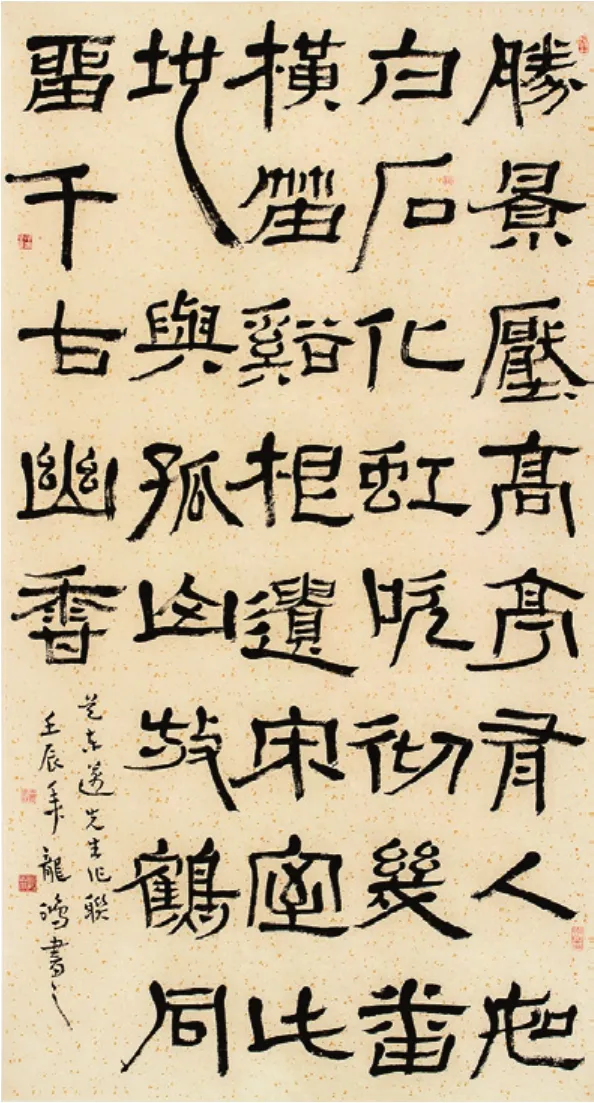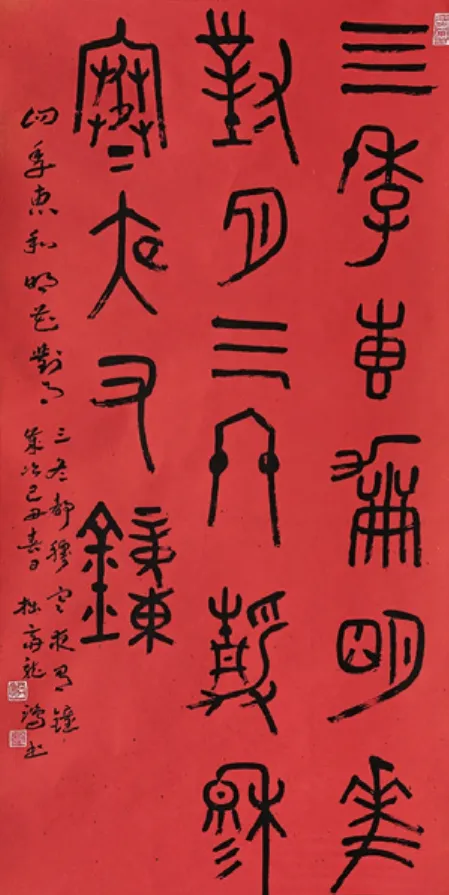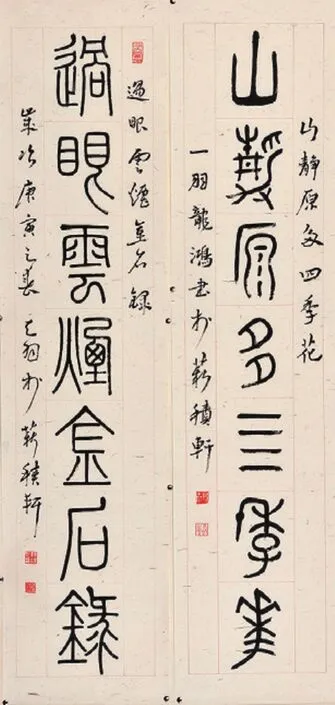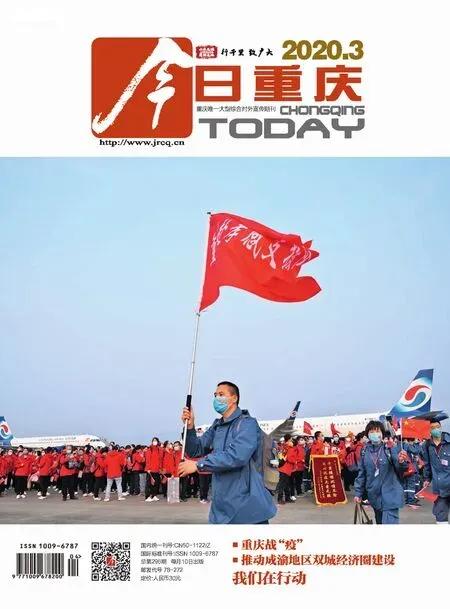龙鸿的笔墨人生
◇| 文本刊记者 陈科龙 图 | 受访者提供
立春后的一天,阳光透过层层叠叠的树叶,钻进了龙鸿的书房。
书案上,名家字帖叠得老高,墙角堆满了临过碑帖的旧报纸、毛边纸。自15岁学习书法起,笔墨成了龙鸿而后几十年人生里无法割舍的部分。旧报纸也好,儿子的旧习题集也好,他都拿来临帖摹碑,不管多忙,每天都会抽出时间与笔墨为伴。书法创作的成就光环下,是对恩师的追思,是其一生学养的凝练。
The day after the beginning of spring, sunshine leaked into Long Hong’s study through layers upon layers of leaves.
In the study, on the desk pile up high copybooks of famous calligraphers, at the corner lade with old newspapers he had used for calligraphy practices. Since Long Hong learned calligraphy at 15 this art has been an indispensable part in his later dozens of years. He takes everything usable, like old newspaper or his son’s scrap books to practice calligraphy by copying the model calligraphic masterpieces. And every day he would spare some time for it no matter how busy he is. Long Hong’s accomplishment in calligraphic mark-making is the recollection of his teachers and the condensation of his ceaseless learning and cultivation.
书写对恩师的追思Respect and Affection for Teachers




龙鸿家客厅里“养拙斋”三个字力透纸背,很是醒目。他双手合十将我迎进客厅,告诉我,那是他健在的博士研究生导师张道一先生所书,当时先生已经目不能视。
而把龙鸿引进门、让他今后有幸与名师结识的,是他的启蒙老师缪孝成。1982年,15岁的龙鸿在重庆第一师范学校读书。学校图书馆管理员缪孝成书法造诣极高,每日晚自习前,学校便安排缪孝成教授学生书法。
“缪老师教了我们两年,受益匪浅。”那时,龙鸿常常在市级书法比赛中获奖,缪孝成夸他字写得很“活”。
毕业后,龙鸿保送至西南师范大学(今西南大学)中文系。在北碚,龙鸿师从著名书法家、教育家徐无闻、荀运昌、秦效侃诸教授。
51岁的龙鸿留着一头精神的短发,侃侃而谈中流露出一股书卷气。谈到徐无闻先生,龙鸿走进书房,取出了他珍藏已久的恩师墨宝。
龙鸿小心翼翼展开卷轴,先生的诗作跃然纸上:
桃园初创日,我正值青年。才见一花放,遽遭风雨残。园荒花不发,我亦点无言。春秋有代序,世事亦推迁。桃园花今再,白发满我颠。白发何须叹,青年在眼前。新篇胜旧作,真见百花繁。诗笔留春住,今朝莫弃捐。
“1957年,西师的文学杂志《桃园》拟创刊,先生曾在杂志上写过文章。1991年5月,《桃园》复刊。先生当时60岁了,又写下了这首发自肺腑的五言古诗。”那时,龙鸿是西师书社社长,蒙徐无闻先生教诲。27年来,他常常取出徐老的墨宝临帖追摩。
In Long Hong’s living room there is an eye-catching calligraphy work “养拙斋” (nurturing stupidity) wrote in powerful and vigorous stroke. He welcomed me into the living room with his palms pressed together and told me that was a piece of work of his doctoral supervisor who had lost his sight when wrote it.


At first the one who introduced calligraphy to Long Hong and broaden his opportunity later is his mentor Miu Xiaocheng. In 1982 when Long Hong was 15, he studied at Chongqing First Normal School. Before the self-study class at night the school assigned Miu Xiaocheng the librarian there who had high attainments in calligraphy to teach students the art.
“Mr. Miu taught us calligraphy for two years. We all learned a lot.” At that time Long Hong often won prizes in Chongqing’s calligraphy competitions and received praises from his teacher that his calligraphy was pretty natural.
After graduation Long Hong was recommended for admission to the Department of Chinese Language under Southwest Normal University (now Southwest University). There he learned calligraphy of renowned masters and professors including Xu Wuwen, Xun Yunchang and Qin Xiaokan.
Though at 51 years of age, Long Hong looks very energetic with short hair and presents a touch of scholarliness during conversation.When speaking of Mr. Xu Wuwen,he walked into the study and took out a scroll of calligraphy work by his teacher which he treasured long.
Long Hong carefully unfolds the scroll, on which writes Mr.Xu’s poem:
When Peach Garden started I was still in my youth. Only seen a single blossom then it was destroyed by a heavy storm!Deserted garden had no flowers in eye, speechless as I was to see the bleak sight. Time went by and things changed a lot. Now the Peach Garden came back and I’m in grey all. But there’s no need to sigh for the aging since we have hope in the new generation, whose articles bloom and exceed the old. Hope the magazine live for good and history never repeat.
“Taoyuan (Peach Garden) is our SWU’s literary magazine.When it was firstly published in 1957, Mr. Xu once wrote articles on it. And till the magazine eventually resumed publication in 1991,he was 60 years old and then he wrote this heartfelt poem.” Long Hong was the chief of SWU Book Community then and Xu Wuwen was a mentor to him. For 27 years he has often taken out Mr. Xu’s calligraphic work for copying and practice.





既要雕虫更要雕龙Integration of Calligraphy and Writing
在古代,书法叫“雕虫”,写文章叫“雕龙”,意在比较两者技艺的高低。龙鸿则把书法看成实用性很强的文人副产品,而他的文人生涯也不止囿于书法创作。
“我是由中文专业转入艺术,由书法篆刻而入美术设计,最终归结至艺术学理论研究。”2004年,龙鸿考入东南大学,师从张道一先生攻读艺术学博士。谈兴正浓,龙鸿拿出他的博士论文,一本厚厚的绿色封皮书册——《大足石刻艺术研究》。
1999年,大足石刻被列入世界遗产名录。在张道一指导下,龙鸿最终将这一家乡的文化瑰宝定为研究对象。当时,大足石刻研究馆老馆长郭相颖得知龙鸿来意后,高兴极了,“因为大足石刻的研究以考古学为主,缺乏艺术学的观照。”
龙鸿白天泡在唐宋时期的宗教摩崖石刻与铭文中,晚上回招待所梳理研究线索,渐渐对佛教神话传说与有关图像创造之间的关系产生了浓厚兴趣。
修完博士学位后,他步履不停,北上清华大学美术学院,做进站博士后。在清华美院,龙鸿笔耕不辍,完成了《古老心灵的发掘——中国古代造物设计与神话传说研究》课题报告。
In ancient times, calligraphy was called Diaochong (carving insects) and writing Diaolong(carving dragon) to compare the two kinds of skills.Long Hong, on the other hand, deems calligraphy as a practical byproduct of the literati, and he himself is never confined to the calligraphic circle.
“I changed my major from Chinese language into art. First it’s calligraphy and seal cutting, then art, and in the end art theory research.” In 2004 Long Hong was enrolled in Southeast University as a doctor in art theory under the supervision of the great artist Zhang Daoyi. In talkative mood, Long Hong fetched out his doctoral paper, a bulky greencovered volume titled with Art Research on Dazu Rock Carvings.
Dazu Rock Carvings was listed as a World Heritage Site in 1999. Under the guidance of Zhang Daoyi, Long Hong eventually chose such a cultural treasure in his hometown as a subject of research. Guo Xiangying, the previous director of Research Institute of Dazu Rock Carvings was terribly glad to see that, “because researches on Dazu Rock Carvings are mainly based on archeology, but lacks the touch of art.”
By day Long Hong was engaged in the religious carvings and inscriptions on the rocks, at night he went back to guest house combing the clues of research. In this way he gradually became obsessed with the relationship between Buddhist legends and related image creation.
After graduation of doctor, he continued his study as a postdoctoral researcher at the Academy of Arts of Tsinghua University. There Long Hong stuck to writing ceaselessly and in the end completed the book Exploration of Ancient Mind: Research on Ancient Chinese Design and Legends.

以学铸人以学养书Cultivation by Learning
艺术理论研究的精进,又反哺着龙鸿的书法创作。
李砚祖教授,龙鸿的博士后指导教师,对龙鸿知之甚深,“作为一名教师和研究者,龙鸿君虽因读书而广涉多科,但对书法艺术研究兴趣一直未减,其研究上自先秦下至当代,多有涉猎,亦有诸多创建和发人深省之处。他的作品以篆、隶、行草为多,不仅功力深厚,而且充满书卷气。功力深厚谓之有骨气;书卷气,谓之文雅、无火气。”
骨气与书卷气既源于为学的滋养,也发自一朝一夕的苦练。
在龙鸿书房的一角,放着一大堆中学生习题集,初见难免诧异。翻开一看,里面竟写满了毛笔字。习题集是龙鸿儿子的旧书,龙鸿不愿当废品卖掉,便在这废弃的书本上练字,前前后后差不多写了上百本。
艺术评论家杨力斌先生曾这样评价,“书家龙鸿善于行书、隶书、章草、草篆等多种书体,作品古典醇和,朴茂自然,清新怡人,呈现出一种随意大方的书卷气线性书写美感浓郁,也彰显出书家潇散雅拙的书学线性审美情趣和优雅意境表现。”
Advance in art theory research in turn nurtures Long Hong’s calligraphy creation.
Professor Li Yanzu, advisor of Long Hong in his post-doctoral period,knows deeply about his student. “As a teacher and researcher, Long Hong has gone on to experiment widely, but his enthusiasm with calligraphy art research never compromises.His researches have touched upon from the pre-Qin period to the modern times and are very much though-provoking. His works are mostly seal script,clerical script and cursive script, full of integrity and elegance.”
All this should be deeply rooted in the nourishment of ceaseless learning and practice as well.
One might be surprised to see the big pile of middle school students’ workbooks in the corner of Long Hong’s study. It turns out that on the books are all practices of calligraphy. These are the used books of Long Hong’s son. He did not want to sell them to junk yards, so just kept them as calligraphy papers. Till now there have been more than 100 workbooks altogether.
“Calligrapher Long Hong is adept at multiple styles like running script, clerical script, etc. His works are archaic and gentle, natural and casual,presenting with beauty and artistic flavor too,”remarked art critic Mr. Yang Libin.

